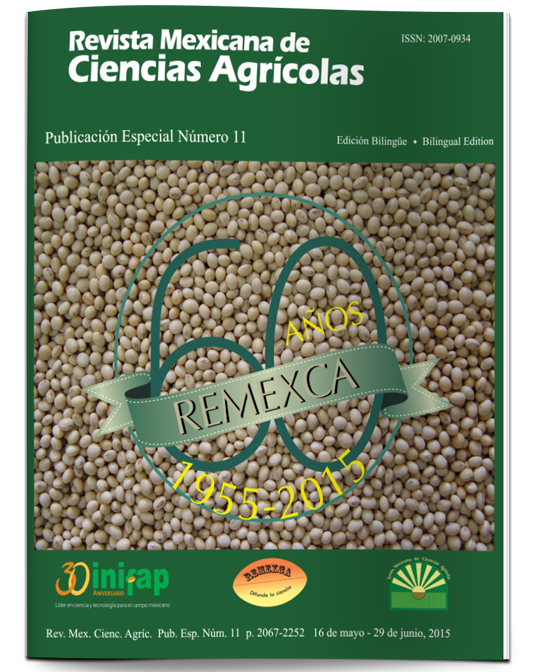Variabilidad fenológica de una población de frijol Patol (Phaseolus coccineus L.) nativo de Durango, México
DOI:
https://doi.org/10.29312/remexca.v0i11.781Keywords:
Phaseolus coccineus L. domesticado, fecha de siembra, fenología vegetal, recursos genéticos vegetalesAbstract
La colección de variedades nativas de Phaseolus coccineus L. del Instituto Nacional de Investigaciones Forestales,Agrícolas y Pecuarias tiene 798 accesiones resguardadas ex situ. Están representadas las variedades del centro y sur del país y hace falta introducir las del norte del territorio. La planta de P. coccineus L. tiene sistema de apareamiento mixto con predominancia del entrecruzamiento por lo que una población puede tener varios colores de semilla y las plantas mostrar diferente fenología. El banco de germoplasma recibió una colecta del Ejido San José de las Corrientes, Municipio de Vicente Guerrero, Durango, México. Se definieron variantes por colores de semilla y se sembraron 25 de junio de 2010 y el 17 de mayo 2011 en Chapingo, México. Se registró: fotoperiodo, días y temperatura acumulada de emergencia de plántula a inicio de f loración, y días y temperatura requerida de f loración a inicio de madurez. Se identif icaron variantes de ciclo corto, 123-144 días, y de ciclo largo de 165 días. En siembras de mayo la planta f loreció a los 26- 36 días con 13.17 y 13.19 horas luz; y en siembras de junio a los 40-56 días con 12.33 y 12.49 horas luz debido a la disminución de fotoperíodo natural a través del tiempo. Al alargarse el período vegetativo aumentó la acumulación de temperatura debido al incremento que ocurre en primavera-verano en esta latitud.Al sembrar en mayo las plantas acumularon en período vegetativo, 468-719 °C, y al sembrar en junio 713-990 °C.
Downloads
Downloads
Published
How to Cite
Issue
Section
License
The authors who publish in Revista Mexicana de Ciencias Agrícolas accept the following conditions:
In accordance with copyright laws, Revista Mexicana de Ciencias Agrícolas recognizes and respects the authors’ moral right and ownership of property rights which will be transferred to the journal for dissemination in open access. Invariably, all the authors have to sign a letter of transfer of property rights and of originality of the article to Instituto Nacional de Investigaciones Forestales, Agrícolas y Pecuarias (INIFAP) [National Institute of Forestry, Agricultural and Livestock Research]. The author(s) must pay a fee for the reception of articles before proceeding to editorial review.
All the texts published by Revista Mexicana de Ciencias Agrícolas —with no exception— are distributed under a Creative Commons License Attribution-NonCommercial 4.0 International (CC BY-NC 4.0), which allows third parties to use the publication as long as the work’s authorship and its first publication in this journal are mentioned.
The author(s) can enter into independent and additional contractual agreements for the nonexclusive distribution of the version of the article published in Revista Mexicana de Ciencias Agrícolas (for example include it into an institutional repository or publish it in a book) as long as it is clearly and explicitly indicated that the work was published for the first time in Revista Mexicana de Ciencias Agrícolas.
For all the above, the authors shall send the Letter-transfer of Property Rights for the first publication duly filled in and signed by the author(s). This form must be sent as a PDF file to: revista_atm@yahoo.com.mx; cienciasagricola@inifap.gob.mx; remexca2017@gmail.
This work is licensed under a Creative Commons Attribution-Noncommercial 4.0 International license.



